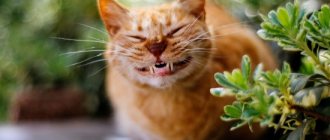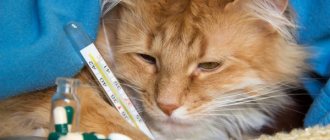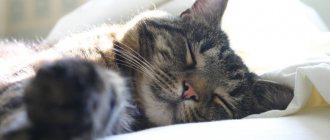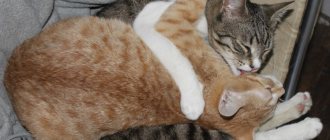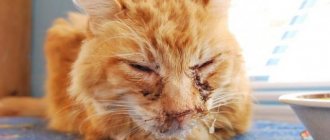Purring is a unique sound that most felines can make during moments of peace. Cat lovers really like to hear their pets purring and feel the vibrations. Of course, there is a desire to repeat the sound made by a pet, but a person cannot simply learn to purr like a cat. Let's look at the reasons and ways to imitate this sound.
Purring heals
Everyone also knows that cats purr with pleasure when everything is fine with them - their belly is full, it’s calm, it’s warm, and their owner gently strokes their fur. But the mustachios turn on their motor and in moments of trouble and pain - giving birth cats, injured and even dying animals purr.
This fact, by the way, confirms the theory about the healing properties of a cat’s purring. There is an assumption that a purring cat produces a certain hormone that acts on the animal as an analgesic and sedative. And some owners claim that their pet’s purring helps them get rid of pain and malaise.
By the way, this is how the continuous vibrating cat sound differs from the short purring - the same one for which Kuprin’s Yu-yu became famous. Do you remember how she interacted with the owners? Her short “murrm” meant “follow me,” “mrm” meant gratitude, “mrum” meant “I’m thirsty,” and “murrum” meant reproach. These sounds are similar to meows and are used by cats to communicate.
Why do cats purr when they're around people?
Why do cats often purr when people are sitting next to them? In general, this is a good signal for pet owners. This way it becomes clear that the cat feels good, cozy, safe with these people, she is happy with her life and the care she receives. Owners who are well acquainted with the nature of cats know that a loud purr means gratitude, and a quiet one simply means the pet is in a good mood or, perhaps, some kind of request.
When cats heal themselves, they purr and heal others around them. It’s not for nothing that they say that cats can cure a person from many diseases, including psychological ones. Thus, cats can cure depression or neurosis, reduce blood pressure and even relieve an attack of angina. Also, the purring of cats helps people with spinal diseases: they relieve pain from paralysis, arthritis, muscle atrophy, and even help astronauts rehabilitate after a flight.
Rarely do cat owners think about why their cute furry cats purr. They are just ready to give them a piece of delicious food for a session of calming purring, which helps get rid of anxiety, stress and just lift their spirits. Maybe that's why cats purr, to please their owners.
Getting a tutor
But let's return to cat lovers who ask how a person can learn to purr like a cat. Unfortunately, no one will be able to repeat this wondrous rattling the first time - simply due to different anatomy. And a cat will not voluntarily reveal its secret of how to purr to a person. But you can use a trick.
First of all, in order to learn to purr, you need to get a personal mustachioed tutor, if you don’t already have one. Did you start it? Now do everything to appease him: buy him the best food, a house, a “sports corner”, toys, a scratcher and scratching post with catnip, a running wheel, a pair of beautiful carriers for traveling to different distances and proclaim him the ruler of the Universe.
How does purring occur?
For a long time, the purring of cats remained a mystery to humans. And even now it is not fully studied.
Initially, scientists tried to find a separate organ that is responsible for producing vibrating sound. But nothing suitable was found. Then they decided that the sound was coming from the cats' stomachs! But they quickly rejected this misconception.
The modern official version is that purring occurs due to the contraction and vibration of muscles that are located near the vocal cords. This is caused by the arrival of certain impulses from the animal’s brain.
A number of systems are used to create such a unique sound:
- nose;
- mouth;
- hyoid bones;
- ligaments
Sound and vibration originate between the base of the skull and the tongue, and then spread throughout the body.
How the purring mechanism is started
Scientists do not fully understand how cats purr. The vocal cords are responsible for the sound, but vibration is explained by more interesting reasons.
Physiological features
The most popular theory to explain how cats purr is the one that focuses on the hyoid bones. In domestic animals they take the shape of a triangle, and in wild animals they take the shape of a rectangle. Because of this, wild feline predators are rarely found purring.
Everything is easier with sound. It passes through the animal's nose and mouth. The heart and lungs at this moment cannot be listened to.
What is known for certain about vibrations is that they appear based on a signal from the brain. When receiving positive and negative emotions, it sends neurons to the responsible organ. This helps to guess what cats purr about.
Unproven facts
When discussing how cats purr from a physiological point of view, we take as a basis the muscles located behind the vocal cords. Their contraction leads to vibration of the hyoid bones, spreading throughout the body. This theory is the most popular, but there are several others. They explain that purring occurs through:
- Lungs
. A purring pet is the result of the work of the diaphragmatic and intercostal muscles. It is assumed that during the breathing process they create sound vibrations of different amplitudes. This is the least popular theory, since the intensity of the purring does not change with inhalation and exhalation.
- False ligaments
. They are located directly above the vocal cords and look like a bunch of elastic membranes. According to this theory, sound vibrations appear due to changes in pressure in the circulating bloodstream. This causes the chest to vibrate and transmit sound to the sinuses.
The hyoid bone theory is more convincing. This is confirmed by the absence of purring in cats with laryngeal paralysis.
Interesting facts about cat purring
There are many interesting facts on this topic that few people know:
- There are situations in history when a pet could imitate simple monosyllabic sentences while purring. Of course, this is simple, but this fact is still quite unusual and interesting.
- Cats “talk” only when completely alone or in the presence of a person. If two animals are in the same room, they do not need this type of communication.
- Purring can be beneficial not only for the cat, but also for the owner. The sounds and vibrations of cats when you pet them have a beneficial effect on the human body: headaches, fatigue, apathy go away, even blood pressure can stabilize in some cases.
- When an animal purrs, the veterinarian cannot listen to the heartbeat; it simply cannot be heard. Therefore, doctors wait until the cat calms down or turn on the water to distract him.
It doesn’t matter how loudly or how long the pet “talks”, what matters is that it does it. After all, in this way a cat shows you its love, appreciation and trust. The animal thanks you for feeding, treating and caring for it in general.
Don't drive away the purring cat! Enjoy his “symphony”, relax your nervous system, become calmer, healthier and happier with him!
Mr. Cat recommends: interesting facts
Purring is a process unique to the animal world. But among the purring ones there are their own records:
- The volume of the rumbling varies in the range from 16 to 100 dts.
- The English cat Merlin purrs four times louder than an ordinary pet. The sound is so loud that it drowns out a running hair dryer. Eyewitnesses compare the cat's purring to the sound of a landing plane.
- The kitten makes its first “murr” at the age of two days.
- The most “purring” country in the world is Australia, where there is a cat for every resident.
For example, cats purr especially intensely during childbirth. This helps them not only calm down, but also breathe correctly.
How can a person learn to purr like a cat?
Having understood the physiology of cats, you can try to transfer this knowledge to the human body. Is it possible to create such sounds with the help of our body? Unfortunately no.
The vocal cords of cats and humans are very different.
A person will never be able to purr like a cat because of the structure of the vocal cords - they are very different. Cats contract the muscles in their larynx, which moves their vocal cords. The process occurs instinctively, unconsciously, and it is impossible to learn.
Sound simulation
A person will not be able to purr like a cat, but you can imitate this sound. After all, a person is very good at imitation, and if he sets a goal, he can purr quite believably.
You should try saying "murrr" by vibrating your throat as you pronounce the "r". Do not cut off the word, but extend the sound as long as possible. As long as the lungs are enough.
The most important nuance in learning is the pronunciation of this drawn-out, throat-vibrating “r”. She needs to burr in the French manner. The technique is discussed in more detail in the article “how to learn to burr p.”
It is clear that the results will only vaguely resemble the purring of a cat, but this is all that human ligaments are capable of.
Which other member of the cat family can purr?
Once you understand how cats purr, it is not so difficult to understand which of their wild relatives is capable of emitting similar sound vibrations. Large cats differ not only in the shape of the hyoid bone, but also in the elasticity of the ligaments. Only the group of small cats has the most flexibility: cheetahs, ocelots and lynxes; they can make purring sounds.
Despite physiology, there are exceptions. Purring large predators include snow leopards, pumas, clouded leopards and leopards. Given the structure of the larynx, their ability is a real mystery.
Why do we like this sound so much?
A person is often a very receptive creature with a subtle mental organization. When a cat comes to you and purrs, it is a sign that she is warm and comfortable next to you, that she feels safe and is not afraid of you. If we have a warm fluffy bundle of happiness and goodness next to us, then what else do we need? At least once in our lives, each of us has asked an unusual question: “How can I learn to purr like that?” Sometimes we feel so good and warm for various reasons that we just want to lie down next to our loved one, hug him and purr with happiness. We like this sound so much that we are ready to forgive our smaller brothers any mistakes and mischief, be it a torn sofa or a puddle in the most inappropriate place.
Find a replacement
A cat play set will provide your pet with the opportunity to jump, exercise and satisfy his curiosity. Stir up your cat's interest by changing her toys, the boxes she hides in, and introducing crumpled pieces of paper for her to chase. Be creative! Tower houses are also great for jumping and climbing exercises. It is important not to deprive the cat of the ability to jump. The ability to jump is built into her DNA and comes from ancestors who had to climb trees to escape predators and stalk prey before leaping. By equipping a special place for jumping exercises, you can wean your pet from other places where its presence is undesirable.
The therapeutic effect of purring
Experienced owners say that cats sense illness, and if the pet always sits on its stomach or chest, you should consult a doctor.
Psychologists distinguish such a concept as feline therapy - a method of treating or preventing various diseases through contact with a cat. Its effectiveness has been confirmed by numerous experiments.
Thus, American scientists have found that when a cat purrs, a person’s blood pressure and pulse normalize. And Russian zoologists have found that cat owners, according to statistics, live several years longer and suffer 20% less from problems with the cardiovascular system.
Today, feline therapy is especially popular for the treatment of diseases such as depression, anxiety, irritability and stress, and migraines.
What are the benefits of purring?
There are opinions that purring has benefits and has a positive effect on the human body. The main ones are:
- soft sound with a special timbre, frequency 27-44 Hz, has a healing effect on the body;
- purring has a positive effect on the health and condition of bones;
- has a calming effect on a person;
- helps get rid of stress and relieve fatigue after work;
- sound vibrations affect human brain activity and help normalize blood pressure;
- a massage can be compared to an acupuncture session.
Some of these misconceptions have no scientific basis and are simple myths that have taken root in society. Having a cat in the house can have a positive impact on a child's development. According to statistics, children who had animals in childhood treat them better.
If a child has contact with a cat before the age of three, the allergens form a strong immunity to allergies. There are other statistics. People who have pets at home live on average 4-5 years longer than those who do not have pets.
Cat-human interaction
The way a cat purrs depends on the person. A purring pet can trample its paws on its owner, lie down on top or next to it. All these actions have their explanation.
Showing affection
If you stroke your mustachioed pet, he will soon begin to purr. This means that he enjoys touch and communication with a person. When stroking against the grain or by a stranger, you can see the opposite effect. The animal will be angry or frightened and will hasten to leave with a threatening hiss.
Foot trampling
The most popular interpretation of trampling is the “milk step”. Kittens make similar movements on their mother's chest, stimulating the faster production of milk. Fingering with paws is also associated with:
showing gratitude and demonstrating trust in a person;
unrealized sexual instinct in castrated animals;
treating the owner or relieving one’s own stress;
preparing a comfortable place to sleep.
If your pet releases its claws when trampling, do not scold it. He does not control this action, so pet him and place a thick blanket or pillow under his paws.
Lying on or next to a person
Lying nearby is the highest form of trust and love. The animal feels safe with its two-legged owner. If a person is unwell, a furry pet can lie on top, sending its healing vibrations to the sore spot.
The most affectionate and “talkative” breeds
How often a cat purrs depends on its individual characteristics. The presence of breed is not a mandatory indicator. A loving owner and comfortable living conditions can awaken the hidden potential of the most ordinary cat picked up on the street.
If you do not want to rely on chance, then it is better to choose a pet among the most “talkative” and affectionate breeds. They quickly become attached to a person and amaze with the variety of their intonations during communication. These breeds include:
Main reasons
There are many versions that explain the reason for the rumbling of domestic cats. The following options are recognized as the main ones.
- Gratitude. Cats purr when they show gratitude to a person for treats, affection, touches and warmth. In this regard, a barely audible purr is a sign of a contented cat.
- Relaxed state. If the pet is in a calm state, then it begins to purr. The same situation can be observed when kittens, sitting in a calm and peaceful state, suck their mother’s milk. Since it is not possible to meow and eat food at the same time, they purr barely audibly.
- Showing your emotions. Most people believe that when a cat purrs, it means the cat is singing its song. With the help of different intonation, pronunciation of sounds and vibrations, pets demonstrate their mood at the current moment. This is comparable to people who, in a relaxed state, begin to hum certain tunes to themselves.
- Conversations between kittens and mother cat. With the help of rumbling, little children tell their mother that everything is fine with them, they are full and satisfied. This indicator is important among wild felines, since parents can often leave their children alone when going hunting.
- When self-medicating. If a cat is sick or stressed, it begins to purr to find peace and restore the state of its body. With the help of vibrations produced by cats, blood circulation processes are improved, which improve metabolism. Purring helps cats warm up or calm down. At such moments, it is better not to touch your pet and let him recover on his own.
- Before bedtime. When an animal is about to sleep, it may purr quietly. Thanks to uniform vibration, he is able to find calm and tune in to sleep. Scientists have conducted studies in which it was found that when rumbling, it is impossible to hear breathing and heart rate, since the vibrations are strong in their manifestation. Due to this feature, pets get a good night's sleep.
- Demonstration of hunting instinct. The rumbling can be heard at the moment when the animal is watching a bird through a window or watching a fluttering leaf in nature. With the help of such manifestations, the animal shows its interest in objects.
- Demonstration of self-defense. A cat may purr loudly if it senses danger. It is better not to touch an animal that is in this state, as you may encounter the fact that the pet may bite or attack.
- Feeling of fear. With severe fear, manifestations of an exciting rumbling may be observed. This suggests that it is better not to touch the animal or, on the contrary, it feels defenseless and needs protection.
- The goal is to get something. If a pet wants to receive a treat from its owner, then it begins to purr. In most cases, this technique works flawlessly, and the cat gets what he wants.
- Disease. Rumbling may indicate illness. In this case, the animal will produce loud and restless sounds. If this behavior occurs, you should contact your veterinarian.
Cats can purr for any reason. However, only very attentive people who care about their little friends are able to understand the true reason for this behavior, and they carefully monitor the well-being and mood of their pet.
The cat doesn't purr
The absence of such sounds from a cat may not only be the result of heredity. Often it occurs due to character traits or a manifestation of resentment towards the owner. Perhaps this is a consequence of distrust of a person, a feeling of discomfort, a feeling that he has become superfluous in the family.
Often a cat does not purr and begins to behave this way after the arrival of a small child in the family. To attract attention to herself, she begins to do dirty tricks, which she has not done before. But the owners' reaction to this may be negative. Try to understand the reason for this behavior and show your pet patience and affection. Then the situation may change and you will again hear him purring gratefully.
How do cats purr?
Who would have thought that such a seemingly trivial question could plunge “great minds” into complete stupor. Until recently, scientists were simply unlucky: they were unable to unravel the mystery of how and why pets make sounds.
Hypotheses
Some suggested that the whole issue was in the vibration of the diaphragm or trachea, other pundits generally blamed the cat's belly for everything. But the whole point is that it was not possible to solve the puzzle due to the examination of immobilized animals that did not make a single sound.
Where is purring born?
Not so long ago, zoologists tried to find an answer to the question of how cats purr . It was believed that this sound was born from vibrations of the diaphragm or trachea; there was even a theory that cats purr using their stomachs. The reason that did not allow zoologists to find out the truth is simple - the studies were carried out on immobilized cats, that is, at the moment when they did not purr.
After New Orleans zoologists changed their research method, they learned how cats purr and where the sound comes from . By conducting studies in natural conditions and using various modern sensors and microphones, they were able to find out why actually purr . The cat's throat contains "false" vocal cords - movable folds that function during inhalation and exhalation. After air enters from the lungs or the environment, vibrations appear on the mucous membrane, and the laryngeal muscles make the sound louder.
Why do cats crumple their claws when you pet them?
Some cats release their claws when they simply lie on their knees. And people often don't like it either. But this is not a form of aggression. This is how animals want to mark their owners. After all, under their claws they have secretion glands, which are secreted directly in order to mark their territory.
There is another theory about this. When you pet a cat, it relaxes, and therefore its muscles too. That's why the claws come out. This happens involuntarily. Every time a cat reaches, it extends its claws. And this is also a way of self-preservation. When a cat lies on your lap and is petted, it relaxes. But she cannot be sure that in 5 minutes she will not be thrown to the floor. Therefore, it is prepared in advance and if they start to drive it away, it will quickly be able to catch on a person’s clothing or the upholstery of a chair.
Does a cat understand a person and how not to offend a cat by saying “meow” to him?
How do cats perceive what we tell them, and what goes on in their heads if we meow in response? Read about the mutual understanding between a cat and a person in this article.
Do cats understand human speech?
Scientists could not reach a consensus on this issue. Some believe that cats perfectly understand human speech, others believe that furry cats have extrasensory and telepathic abilities, thanks to which they perceive what a person says to them.
Of course, the meaning of the words we say to them is hardly clear, but there are a large number of additional factors that play a big role in the mutual understanding of a person and his pet.
Important factors due to which a cat understands you
1. Features of cat hearing. The range of sounds perceived by cats is much wider than that of humans. According to scientists, cats can remember up to 100 words. This fact does not mean that your pet understands the meaning of your words, but he will definitely not miss his nickname and invitation to eat.
2. Intonation and rate of speech are also important factors. As an experiment, you can say different phrases with the same intonation and the cat will most likely react the same way.
3. Smells. If your pet smells something tasty, he will undoubtedly come running even without any invitations. Also, with the help of an unpleasant smell for a cat, you can designate places that are forbidden for him.
4. Body language. Cats are very attentive to human actions; some cats wait for permission to jump up to their owner, and by placing your hand next to them or patting your lap, you give him this permission.
5. Sensitivity to a person’s mood and health status. Well, we can probably do without comments here, furry pets are psychics.
Learning to purr
But seriously, surround the cat with love and in a moment of peace, lie down next to him and gently stroke him. As soon as the cat begins to purr, the person should, breathing only through his nose, try to tune in to the cat's frequency and try to make a sound as similar as possible to purring. Don't be discouraged if all you get out is grunting at first. Over time, a persistent student will definitely succeed.
Hearing a person purr, the cat will probably feel even more love for him. Well, in the company of your own kind, you can always make a splash! But you can make everyone laugh and surprise, but it’s unlikely that you can heal. This secret knowledge is hardly transmitted along with the purring skill.
So good luck with your studies! And remember: all cats purr at the same frequency - 25 cycles per minute, and nothing else. And finally, a poem!
How do cats purr?
People seem fascinated by animals that can do things we can't. For example, HowStuffWorks has answers to questions about camel slides, hawk vision, night vision, fish gills, and more.
It's the same with cats purring. We can't purr, so we're interested in how cats can do it. It turns out that domestic cats, some wild cats like cougars and mountain lions (basically any big cat that can't growl) and even raccoons can all purr. People smile and laugh when they're happy, and dogs wag their tails. So it's a common physical response to happiness for animals. Cats show happiness by purring. They may also purr when scared or upset.
It turns out that cats have special wiring! Wiring runs from the brain to the muscles of the voice box, and this wiring is capable of causing the muscles to vibrate so that they act as a valve for air to flow past the voice box. The muscles work both during inhalation and exhalation, which gives the impression that cats can continuously purr. Air passes through a valve that quickly opens and closes, creating a purring sound.
To learn more about cats, use the links on the next page.
Theories about the nature of purring
When kittens are born, they are already purring. They also do this in the process of sucking the mother’s milk, which has a calming effect both on her and on the “babies” themselves. Where did this purring come from?
Vocal cords
The cat's vocal cords vibrate, followed by the hyoid bones. From them the vibration moves to the whole body, so it seems that the cat is “groaning”
Paying attention to a purring cat, you will notice that she does this regardless of inhalation/exhalation of air. Thus, the conclusion suggests itself that purring is a vibration of the hyoid bones and all muscles of the body, and not a sound produced by an animal
Cat massage
There are many guesses why the pet purrs and tramples its owner with its paws. Here are some of them:
- Memories of childhood, or “milk step” - kittens knead their mother with their paws while feeding to quickly obtain milk. This brings them pleasure and is associated in adults with a feeling of comfort, satiety and security.
- Prepares a comfortable place to sleep - tramples the surface on which you are going to sleep for the greatest comfort. The owner's knees may well be suitable for this purpose.
- Gratitude - in this way one can say “thank you” for delicious food, warm shelter, tenderness and affection.
- Therapeutic massage is a common theory that this is how a cat treats its owner from ailments.
- Stress relief – by purring and moving their paws, cats lift their spirits, relax and calm down.
- Unfulfilled sexual instinct - one theory says that if an animal does not have a mate, it may show unambiguous interest.
- Marks its property - cats have glands on their paw pads that secrete a secretion. This is one of the ways to convey to other animals that a person belongs to him.
- Showing trust and love - the pet shows its owner its location, favor, openness and trust. Emphasizes your closeness with a person.
This massage soothes, relaxes and helps relieve stress. But what if claws are used? You can lightly press the cat towards you so that he lies down and stops trampling. You should not scold or drive out an animal if its trust and peace of mind are valuable. It’s better to just put a blanket or pillow on your knees in advance.
Reference! A cat will reflexively retract its claws if you stroke the top of its paws.
What does purring mean?
An interesting fact is that the vibrating sound made by cats is the result of several factors.:
- manifestation of emotions. The kittens signal to the cat that everything is fine. Then the adult purrs and thereby tries to tell the owner about it,
- an expression of pleasure. This is a kind of sign of gratitude for delicious food, comfort and affection. In general, being in a good mood can be a reason to purr under your breath,
- calmness. This is a way to calm down after suffering stress, especially when stroked by the owner. After all, the kitten purrs when sucking its mother’s milk and this is a natural process. Therefore, an already adult cat calms down from the sound of its purring. Sometimes in this way he prepares himself for sleep. Then there is no loud purring, rather it will be quiet,
- a sign of threat or a mood to hunt. Purring can not only be kind and affectionate, it can sound quite aggressive. This is how the cat makes it clear that this is his territory. The hunter guarding the birds purrs loudly, tuning in to the hunting process.
If a cat never purrs, it may be due to his personality. Some individuals, like people, simply do not like to show emotions.

